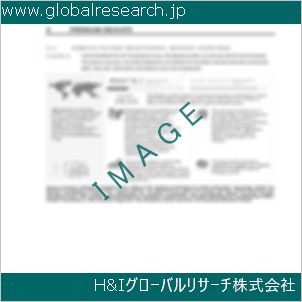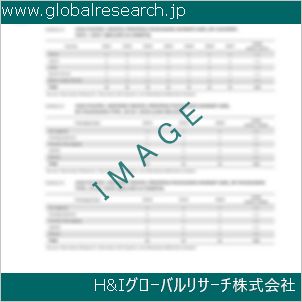Table of Contents
1 Industry Overview of Thallium
1.1 Definition and Specifications of Thallium
1.1.1 Definition of Thallium
1.1.2 Specifications of Thallium
1.2 Classification of Thallium
1.3 Applications of Thallium
1.3.1 Nuclear Application
1.3.2 Non-Nuclear Application
1.4 Industry Chain Structure of Thallium
1.5 Industry Overview and Major Regions Status of Thallium
1.5.1 Industry Overview of Thallium
1.5.2 Global Major Regions Status of Thallium
1.6 Industry Policy Analysis of Thallium
1.7 Industry News Analysis of Thallium
2 Manufacturing Cost Structure Analysis of Thallium
2.1 Raw Material Suppliers and Price Analysis of Thallium
2.2 Equipment Suppliers and Price Analysis of Thallium
2.3 Labor Cost Analysis of Thallium
2.4 Other Costs Analysis of Thallium
2.5 Manufacturing Cost Structure Analysis of Thallium
2.6 Manufacturing Process Analysis of Thallium
3 Technical Data and Manufacturing Plants Analysis of Thallium
3.1 Capacity and Commercial Production Date of Global Thallium Major Manufacturers in 2023
3.2 Manufacturing Plants Distribution of Global Thallium Major Manufacturers in 2023
3.3 R&D Status and Technology Source of Global Thallium Major Manufacturers in 2023
3.4 Raw Materials Sources Analysis of Global Thallium Major Manufacturers in 2023
4 Capacity, Production and Revenue Analysis of Thallium by Regions, Types and Manufacturers
4.1 Global Capacity, Production and Revenue of Thallium by Regions 2019-2024
4.2 Global and Major Regions Capacity, Production, Revenue and Growth Rate of Thallium 2019-2024
4.3 Global Capacity, Production and Revenue of Thallium by Types 2019-2024
4.4 Global Capacity, Production and Revenue of Thallium by Manufacturers 2019-2024
5 Price, Cost, Gross and Gross Margin Analysis of Thallium by Regions, Types and Manufacturers
5.1 Price, Cost, Gross and Gross Margin Analysis of Thallium by Regions 2019-2024
5.2 Price, Cost, Gross and Gross Margin Analysis of Thallium by Types 2019-2024
5.3 Price, Cost, Gross and Gross Margin Analysis of Thallium by Manufacturers 2019-2024
6 Consumption Volume, Consumption Value and Sale Price Analysis of Thallium by Regions, Types and Applications
6.1 Global Consumption Volume and Consumption Value of Thallium by Regions 2019-2024
6.2 Global and Major Regions Consumption Volume, Consumption Value and Growth Rate of Thallium 2019-2024
6.3 Global Consumption Volume and Consumption Value of Thallium by Types 2019-2024
6.4 Global Consumption Volume and Consumption Value of Thallium by Applications 2019-2024
6.5 Sale Price of Thallium by Regions 2019-2024
6.6 Sale Price of Thallium by Types 2019-2024
6.7 Sale Price of Thallium by Applications 2019-2024
6.8 Market Share Analysis of Thallium by Different Sale Price Levels
7 Supply, Import, Export and Consumption Analysis of Thallium
7.1 Supply, Consumption and Gap of Thallium 2019-2024
7.2 Global Capacity, Production, Price, Cost, Revenue, Supply, Import, Export and Consumption of Thallium 2019-2024
7.3 USA Capacity, Production, Price, Cost, Revenue, Supply, Import, Export and Consumption of Thallium 2019-2024
7.4 EU Capacity, Production, Price, Cost, Revenue, Supply, Import, Export and Consumption of Thallium 2019-2024
7.5 China Capacity, Production, Price, Cost, Revenue, Supply, Import, Export and Consumption of Thallium 2019-2024
7.6 Japan Capacity, Production, Price, Cost, Revenue, Supply, Import, Export and Consumption of Thallium 2019-2024
8 Major Manufacturers Analysis of Thallium
8.1 Manufacturer One
8.1.1 Company Profile
8.1.2 Product Picture and Specifications
8.1.2.1 Type I
8.1.2.2 Type II
8.1.2.3 Type III
8.1.3 Capacity, Production, Price, Cost, Gross and Revenue
8.1.4 Contact Information
8.2 Manufacturer Two
8.2.1 Company Profile
8.2.2 Product Picture and Specifications
8.2.2.1 Type I
8.2.2.2 Type II
8.2.2.3 Type III
8.2.3 Capacity, Production, Price, Cost, Gross and Revenue
8.2.4 Contact Information
8.3 Manufacturer Three
8.3.1 Company Profile
8.3.2 Product Picture and Specifications
8.3.2.1 Type I
8.3.2.2 Type II
8.3.2.3 Type III
8.3.3 Capacity, Production, Price, Cost, Gross and Revenue
8.3.4 Contact Information
8.4 Manufacturer Four
8.4.1 Company Profile
8.4.2 Product Picture and Specifications
8.4.2.1 Type I
8.4.2.2 Type II
8.4.2.3 Type III
8.4.3 Capacity, Production, Price, Cost, Gross and Revenue
8.4.4 Contact Information
8.5 Manufacturer Five
8.5.1 Company Profile
8.5.2 Product Picture and Specifications
8.5.2.1 Type I
8.5.2.2 Type II
8.5.2.3 Type III
8.5.3 Capacity, Production, Price, Cost, Gross and Revenue
8.5.4 Contact Information
…
9 Marketing Trader or Distributor Analysis of Thallium
9.1 Marketing Channels Status of Thallium
9.2 Traders or Distributors with Contact Information of Thallium by Regions
9.3 Ex-work Price, Channel Price and End Buyer Price Analysis of Thallium
9.4 Regional Import, Export and Trade Analysis of Thallium
10 Industry Chain Analysis of Thallium
10.1 Upstream Major Raw Materials Suppliers Analysis of Thallium
10.1.1 Major Raw Materials Suppliers with Contact Information Analysis of Thallium
10.1.2 Major Raw Materials Suppliers with Supply Volume Analysis of Thallium by Regions
10.2 Upstream Major Equipment Suppliers Analysis of Thallium
10.2.1 Major Equipment Suppliers with Contact Information Analysis of Thallium
10.2.2 Major Equipment Suppliers with Product Pictures Analysis of Thallium by Regions
10.3 Downstream Major Consumers Analysis of Thallium
10.3.1 Major Consumers with Contact Information Analysis of Thallium
10.3.2 Major Consumers with Consumption Volume Analysis of Thallium by Regions
10.4 Supply Chain Relationship Analysis of Thallium
11 Development Trend of Analysis of Thallium
11.1 Capacity, Production and Revenue Forecast of Thallium by Regions and Types
11.1.1 Global Capacity, Production and Revenue of Thallium by Regions 2024-2029
11.1.2 Global and Major Regions Capacity, Production, Revenue and Growth Rate of Thallium 2024-2029
11.1.3 Global Capacity, Production and Revenue of Thallium by Types 2024-2029
11.2 Consumption Volume and Consumption Value Forecast of Thallium by Regions, Types and Applications
11.2.1 Global Consumption Volume and Consumption Value of Thallium by Regions 2024-2029
11.2.2 Global and Major Regions Consumption Volume, Consumption Value and Growth Rate of Thallium 2024-2029
11.2.3 Global Consumption Volume and Consumption Value of Thallium by Types 2024-2029
11.2.4 Global Consumption Volume and Consumption Value of Thallium by Applications 2024-2029
11.3 Supply, Import, Export and Consumption Forecast of Thallium
11.3.1 Supply, Consumption and Gap of Thallium 2024-2029
11.3.2 Global Capacity, Production, Price, Cost, Revenue, Supply, Import, Export and Consumption of Thallium 2024-2029
11.3.3 USA Capacity, Production, Price, Cost, Revenue, Supply, Import, Export and Consumption of Thallium 2024-2029
11.3.4 EU Capacity, Production, Price, Cost, Revenue, Supply, Import, Export and Consumption of Thallium 2024-2029
11.3.5 China Capacity, Production, Price, Cost, Revenue, Supply, Import, Export and Consumption of Thallium 2024-2029
11.3.6 Japan Capacity, Production, Price, Cost, Revenue, Supply, Import, Export and Consumption of Thallium 2024-2029
12 New Project Investment Feasibility Analysis of Thallium
12.1 New Project SWOT Analysis of Thallium
12.2 New Project Investment Feasibility Analysis of Thallium
13 Conclusion of the Global Thallium (CAS 7440-28-0) Industry 2024 Market Research Report
| ※参考情報 タリウムは、記号Tlおよび原子番号81を持つ元素であり、周期表の13族に属する金属です。タリウムは、1875年にスウェーデンの化学者であるアンドers Gustaf Ekebergによって発見されました。これは、青緑色の光を放つタリウム(Thallium)という鉱石から名付けられています。タリウムは自然界において非常に希少な元素であり、主に鉱石として砒素鉱や鉛鉱に微量存在しています。 タリウムの物理的性質としては、銀白色の柔らかい金属であり、常温では固体の形態を保っています。酸化状態の変化が豊富で、特に+1と+3の酸化状態が一般的です。+1の酸化状態はタリウムの化学的特徴の基盤であり、これが多くの化合物で見られます。また、タリウムは、高い密度と融点を有し、多くの金属と同様に電気を良く導通します。 タリウムはさまざまな種類の化合物を形成する能力を持ため、産業における用途が広がっています。代表的なタリウム化合物には、タリウム(I)酸化物(Tl2O)、タリウム(I)硫化物(Tl2S)、およびタリウム(III)塩が含まれます。これらの化合物は、半導体材料、光学デバイス、蛍光体、および体外診断薬など、様々な分野で利用されており、特に電子産業や医療分野において重要な役割を果たしています。 タリウムの用途の一つに、特殊なガラスやクリスタルの製造があります。タリウムが添加されることで、これらの材料の光学的特性が向上し、より高性能な製品を生み出すことが可能になります。さらに、タリウム系の化合物は、例えば、鉛フリーのガラスに利用されることが多く、環境への配慮も考慮されています。 医療分野においては、タリウムの放射性同位体が特に注目されています。タリウム-201は心筋の画像診断に使用され、心臓の血流を評価する際に重要な役割を果たしています。心筋の異常や虚血の評価において、非常に敏感な手段となっています。このように、タリウムは医療分野においても重要な位置を占めています。 タリウムの関連技術としては、環境浄化技術や電子材料の開発における研究が挙げられます。タリウムを含む材料は、特に電子デバイスにおいては、デバイスの集積度や性能を向上させるための鍵となります。また、タリウムを含む廃棄物処理技術も注目されており、タリウムのリサイクルや安全な処理方法が模索されています。 ただし、タリウムには注意すべき健康リスクも存在します。タリウムは毒性があり、摂取や吸入によって中毒を引き起こす可能性があります。そのため、タリウムを取り扱う際には十分な注意が必要です。また、タリウムの環境中への放出も懸念されており、これに対する規制や対策が求められています。 近年、タリウムに関する研究は進んでおり、特にその特性を応用した新しい技術の開発が期待されています。タリウムのナノ材料化や新しい合成方法が探求されており、これらの技術が今後の産業にどのような影響を持つかが注目されています。 タリウムは、元素としての特徴、さまざまな化合物の特性、医療や産業における広範な用途、そして環境や健康に関連するリスクまで、多岐にわたる重要な役割を持つ元素です。その多様な応用可能性とともに、タリウムの持つ課題についても理解し、適切に取り扱うことが求められます。これにより、タリウムは将来的により良い技術開発に貢献する可能性があり、引き続き研究や開発が進められることが期待されています。 |
❖ 免責事項 ❖
http://www.globalresearch.jp/disclaimer












